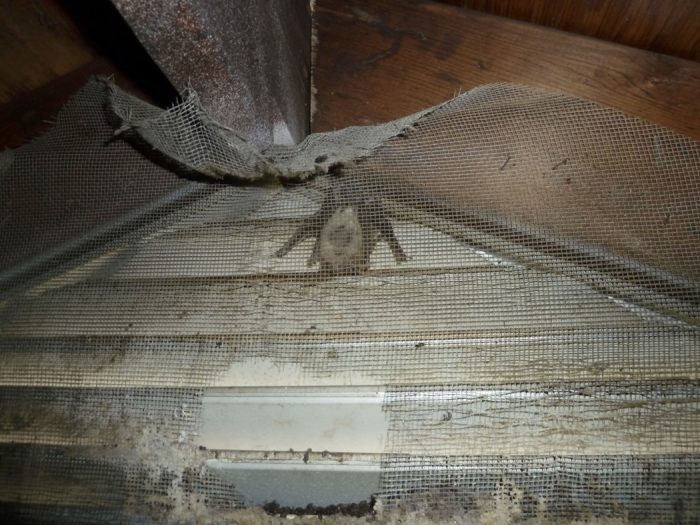THE DANGER OF RABIES FROM BATS
The following information is from a county health department in Colorado but will be relevant for much of the United States and- at least the risk portion of it- for Canada.

RISKS
Home inspectors visit attics fairly often and it’s not unusual for them to encounter bats occasionally. Bats typically sleep during the day and remain hidden, but as an inspector moves through an attic, he may disturb them. Once they start to fly, the chances of coming into contact with them increases.
Bats are the #1 transmitter of rabies to humans that result in fatalities. On the average, only about 1% of bats in a bat population are infected with rabies. This percentage can vary with different bat populations across the continent, and so can the size of local bat populations. Inspectors can get information about bat populations and the risk of rabies from the county health departments of the areas in which they work.
Generally, the risk of contracting rabies from bats while inspecting attics is low, but the results of exposure are potentially serious, and potentially very expensive! Once symptoms have developed, rabies is fatal.
People can only be infected by bats by direct contact. Rabies is transmitted to humans through bat saliva (or spinal fluid). This means transmission happens either by being bitten or- due to grooming- contact with claws. Personal protective equipment (PPE) is helpful but to be completely protected you’d need to be dressed like a beekeeper!
Once bats have been disturbed and are flying in the attic, inspectors may be exposed (may have contact with them) without being aware of it. Bats have extremely sharp teeth and claws and inspector may not feel the contact. Bat teeth or claws can infect a person with the rabies virus.
Once bitten or scratched, to determine whether the bat was infected, the inspector would need to catch the bat with whom they had contact and take it to the county health department where it would be tested. Because bats often roost in colonies, catching the right bat would obviously be difficult.
Pre-exposure Vaccinations
The least expensive prevention is to be vaccinated before you’re exposed. Vaccine availability varies by area. Locations for vaccinations in the US may include pharmacies, county health departments, medical facilities, and sometimes Walgreens.
Pre-exposure vaccinations require two separate inoculations, 7 days apart, each costing over $300, although this also varies by area, It is seldom covered by insurance. Workmen's comp may reimburse you. contact your insurance company or the local health department to find the best price.
Once Infected
Once a person is infected there will be an incubation period. The virus enters tissue from the bite or scratch and moves through tissue until it encounters a nerve ending. It climbs the nerve ending toward the brain at the rate of a few centimeters a day. Once it reaches the brain, symptoms develop and rabies becomes fatal. The time required for the virus to reach the brain depends on the location of the initial infection. Being bitten on the foot or lower leg would allow the most symptom-free time. Being bitten on the face or scalp would be the worst scenario.
Post-exposure Vaccinations
This is the scary part! Without pre-exposure vaccinations, once an inspector has been exposed, four inoculations are required. The first can only be obtained at an emergency room, and requires a two-part inoculation; the vaccine, and human rabies immune globulin (HRIG). The vaccine is slow acting and the purpose of the HRIG is to speed the time required for the vaccine to become effective in preventing symptoms from developing.
The 2nd, 3rd, and 4th doses of rabies vaccine can be given at wherever the Emergency Department arranges, and these can be at outpatient clinics associated with the Emergency Department practice.
Note: The vaccination doses must be coded as Rabies post-exposure treatment in order for either your worker’s compensation medical practice or your private health insurance to cover it.
The cost of the HRIG inoculation can vary from $10,000 to $25,000, but is typically covered by insurance. Three more vaccinations given at specific intervals are required after the initial vaccination. Some people may have reactions, typically mild, to rabies vaccinations. Those with weakened immune systems may be at higher risk from vaccinations. Vaccinations must begin before the development of symptoms.
For those who have already been vaccinated before their exposure, the procedure will be different, and they will not need the HRIG inoculation.
For those infected in Canada, costs are minimal!
YOUR CLIENTS
A client called me about three months after an inspection saying they awoke and there were two bats in the bedroom. I laughed and then called the health department. I stopped laughing. The health department recommended that they receive post-exposure inoculations.
It doesn't end there. Let’s say the client has two dogs and two cats. If the animals may have been exposed, they must be quarantined for a period of at least three months, often four. Figure quarantine costs at around $25 a day per animal. This would result in a bill for about $8,400 for four pets, plus the cost of inoculations for anyone in the family with a possible exposure.
This is all worst-case scenario, but that doesn't mean it can't happen.
